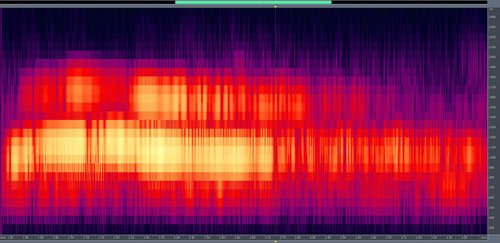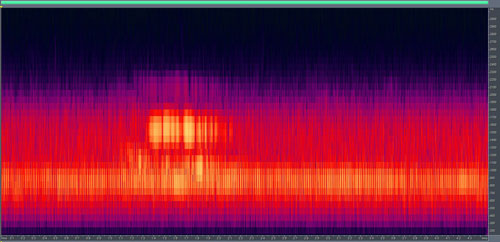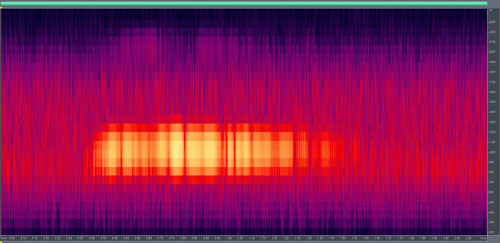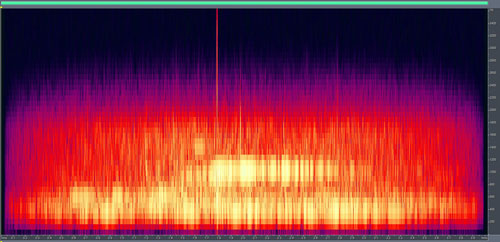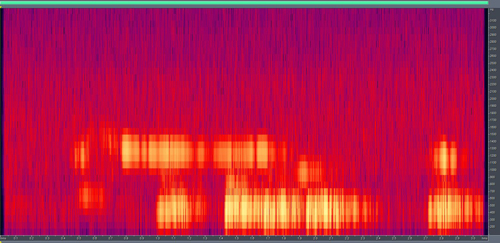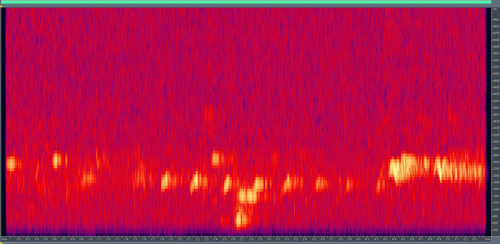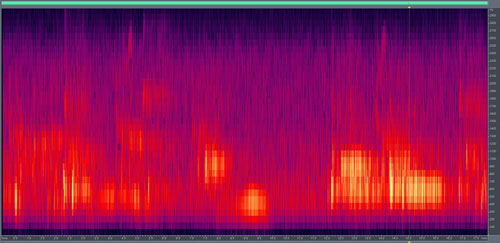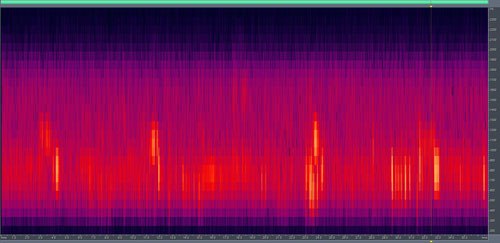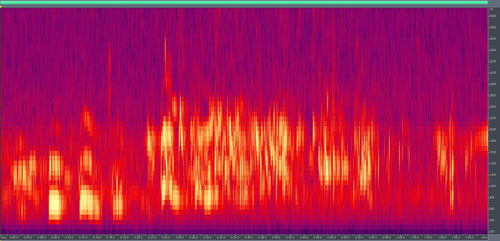Voices
Click here to listen to sound clip: Â Voice 4
Waveform View
Spectral View
Click here to listen to sound clip:Â Voice 5
Waveform View
Spectral View
Click here to listen to sound clip:Â Voice 6
Waveform View
Spectral View
Click here to listen to sound clip:Â Voice 7
Waveform View
Spectral View
Click here to listen to sound clip:Â Voice 8
Waveform View
Spectral View
Click here to listen to sound clip:Â Voice 9
Waveform View
Spectral View
Click here to listen to sound clip:Â Voice 10
Waveform View
Spectral View
Click here to listen to sound clip:Â Voice 12
Waveform View
Spectral View
Click here to listen to sound clip:Â Voice 13
Waveform View
Spectral View
Click here to listen to sound clip: Voice 14
Waveform View
Spectral View
Click here to listen to sound clip: Voice 15
Waveform View
Spectral View
Click here to listen to sound clip: Voice 16
Waveform View
Spectral View
Click here to listen to sound clip: Voice 17
Waveform View
Spectral View
Click here to listen to sound clip: Voice 18
Waveform View
Spectral View
Howls
Click here to listen to sound clip: Howl 1
Waveform View
Spectral View
Click here to listen to sound clip: Howl 2
Waveform View
Spectral View
Click here to listen to sound clip: Howl 3
Waveform View
Spectral View
Click here to listen to sound clip: Howl 4
Waveform View
Spectral View
Click here to listen to sound clip: Howl 5
Waveform View
Spectral View
Click here to listen to sound clip: Howl 6
Waveform View
Spectral View
Media Article – Madison County, Illinois – # 7
Thursday May 5, 2011
Has Madison County Been Visited By Sasquatch?
By Steve Rensberry, Reporter Troy Times-Tribune
Madison County has had its share of mysteries over the years, from UFO sightings to ghosts to black panthers. Traverse the state and you'll come across the legend of the Gooseville Bear, the Stump Pond Serpent, giant Thunderbirds, the Cole Hollow Road Monster, the Murphysboro Mud Monster, the Enfield Horror and the Farmer City Monster. Then there's Bigfoot--or Sasquatch if you prefer. Missouri's Momo, the Yeti or Abominable Snowman of the Himalayan region and a few other stealthy creatures of lore bear some similarities. Before you brush it off as just another tale, on par with seances and alien abductions, consider that the legend of Bigfoot hinges to a large extent on simple eye-witness reports and basic science. The legendary creature is considered to be what's called a bipedal cryptid and the subject matter of a field of study known as cryptozoology, loosely defined as the study of relatively hidden animals for which evidence is primarily circumstantial and anecdotal.
"Photo Courtesy - Troy Times-Tribune"
Bigfoot Field Researchers Organization Investigator Stan Courtney stands next to Silver Creek, near where it crosses Illinois Route 4 and close to the alleged sighting of a Sasquatch that took place in 1980. According to one local source—who asked to remain anonymous for fear of reprisal—evidence for the elusive hairy giant may be scarce but sightings in the Troy and St. Jacob area, and in other parts of Madison County, are not unheard of. And while he himself has never seen one, he has his suspicions. One source of reports is the Bigfoot Field Researchers Organization (BFRO), founded in 1995 and headquartered in Orange County, California. Its director and co-founder is a man by the name of Matthew Moneymaker. Another is the Texas-based Gulf Coast Bigfoot Researchers Organization. Both organizations publish online databases of sightings around the U.S. "I have a friend who recently had a sighting within about 50 miles of Chicago and this spring there was a sighting 15 miles from the St. Louis Arch. I hear about lots of reports that never get published," BFRO researcher Stan Courtney wrote in an online post dated September 2009. One of the closest reported sighting allegedly occurred on Christmas Eve in 1980 along Illinois Route 4 near Silver Creek, approximately one-quarter of a mile north of U.S. Highway 40. The report was submitted to BFRO. "The witness stated that the animal was very muscular with a neck like a bodybuilder and a large head. Facial features were very ape-like, the entire body was covered in a two-inch long dark and shaggy hair. This location is next to an intermittent stream running into Silver Creek which runs into the Kaskaskia River near New Athens." According to the report, the subject (who remains anonymous, as in all BFRO reports), had just turned onto Route 4 and had begun picking up speed when he saw the creature in the middle of the roadway. He then turned on his bright lights and hit the brakes. "I came within inches of it and was looking at it the whole time. It was standing up but seemed to be kind of bent over at the waist and it was holding its right arm up against its chest (like if you would have your arm in a sling). I estimate it was well over seven foot tall," the witness said. Another BFRO report details an incident in June of 2006 in Pin Oak Township not far from where Illinois Route 143 approaches Edwardsville. This one involved both an eye-witness claim and a suspicious footprint measuring about 14 inches long by five inches wide. The report was submitted by the husband of the woman who allegedly saw the creature, which she said was about 10 feet away from her as she pulled into their driveway. Courtney paid three visits to the site. "After our first conversation, the witness called and stated that a footprint was found in the woods behind the house." Courtney noted. "I asked that the footprints be covered to be protected and I would visit the property." His report describes a tall, thinly-built creature with narrow shoulders and weighing approximately 250 pounds. "Although the witness saw the face, it was so hairy that she was unable to make out any details," he said. In a recent interview with the Times-Tribune, Courtney, 62, said he is one of about five BFRO field investigators in Illinois and that Missouri has about six, though he is one of the most active. Courtney, who comes across as straightforward and down-to-earth, lives near Litchfield and retired in 2009 after 35 years with St. John's Hospital in Springfield. He has been a member of BFRO since 2004. "It's really a complex subject, and one of the things that makes it complex is you're dealing with people," he said. One of Courtney's specialties is wildlife audio recording and analysis. He also maintains a comprehensive listing of reported Bigfoot encounters in Illinois on his website at www.stan-courtney.com, in addition to a Facebook page. He gives presentations before any number of groups, from those interested in the paranormal to UFO groups to those of a more scientific persuasion. On April 17, Courtney was a guest speaker at a Springfield Ghost Society meeting . Another pending engagement is with the U.S. Army Corps of Engineers. Illinois ranks number seven nationwide in the number of Bigfoot encounters, with reported sightings in 76 out of 102 counties, Courtney says on his site. He estimates that the State of Illinois has more than 87,000 miles of wooded streams and rivers and said a sizable amount of its total land area consists of woods or forest areas. Although he believes only a small percentage of possible Sasquatch sightings are ever reported, as much as 50 percent turn out to be hoaxes while another 35 percent involve "something" but do not contain enough information to say what it was, he said. That leaves only about 15 percent of reported encounters that have some measure of legitimacy. Will we ever know the truth? Do the alleged Bigfoot sightings in Madison County involve the same species as those reported elsewhere? Until someone actually captures one, either with high-definition photo equipment or in real life, we won't really know. What we do know is that reputed sightings of large, hairy creatures similar to Bigfoot have been around almost as long as humans have—a fact which Courtney suggests adds to its credibility. The famous Patterson/Gimlin film captured at Bluff Creek, California in 1967 is still considered by many people as the best evidence to date of a real, live Sasquatch—despite its controversy. Before you get primed for your own Bigfoot search, here's one more report, this one from neighboring Bond County and listed in the Gulf Coast Bigfoot Researcher Organization's database. Entered on October, 1985, the database entry cites a breaking daylight encounter where a hunter, safely hidden within a deer stand, heard something the likes of which he'd never heard before. As told by an acquaintance: "After he was in his deer stand for about 10 minutes . . . something that sounded like a man walking walked in the same way he did and walked right past his stand about 50 yards past. It started beating on its chest and got evidently very mad and started tearing up trees and stuff. It was growling and stuff, making mad sounds. When the horizon in the east just started to show, it ran down towards the creek in about 10 leaps, estimated speed about 40 miles per hour or faster. No footprints, no hair, just this freaky ordeal." The report cites two other people who claim to have heard strange sounds, including on one occasion a "terrifying scream," coming from the same area, once in 1967 and again in 1988.
Bears Sighting In Illinois?
Monday, May 17, 2010
Bears sighted in Illinois?
Tiskilwa (Bureau County) — Officially, there are no Bears loose in Illinois aside from the ones who wear helmets and shoulder pads eight Sundays a year at Soldier Field.
Unofficially, Bureau County Deputy Sheriff Sherry Barto believes she saw two of the wild, fur-covered variety Saturday morning in a field near Tiskilwa, about 50 miles north of Peoria.
People who live in the area reported seeing a mother and cub, and Barto, sure enough, saw what looked like a pair of bears about 10:30 a.m.
The animals were moving into some heavy brush, and she didn’t have a chance to get a photo, she said.
Illinois Conservation Police Sgt. Robert Frazier has heard all kinds of reports about sightings in areas where wild animals shouldn’t be.
“People see mountain lions. They see bears,†Frazier told the (Peoria) Journal Star. “And I’ve always halfway dismissed them. But then we find a mountain lion in Chicago. We find a bear in Bureau County. You can’t dismiss them.â€
The mountain lion he referred to was found in Chicago in 2008, and the bear was found last year. It was hibernating in a drainage ditch near Neponset, less than 20 miles from Tiskilwa.
Frazier helped catch that bear, which was sent on to a zoo in Coal Valley in western Illinois.
A mother bear, he warned, could be aggressive.
“I would think her nurturing instinct would be to protect her cub,†Frazier said. “I wouldn’t be traipsing around in the woods looking for it.â€
And he wonders, given the proximity to last year’s bear find, whether that bear and these two — if the animals spotted Saturday really were bears — were kept by someone on their property.
“People sometimes take wild animals from the wild,†Frazier said. “They think they’re cute, and then the darn thing gets bigger, does damage to the home, gets out, and it’s not such a good idea.â€
Mercer County Cougar
4th December 2004
New Boston, Ill. ҠKenny Tharp of rural Mercer County, Ill., is an experienced hunter who has traveled to Utah over the years to pursue mountain lions, a creature he never had seen in his neck of the woods.
Until Saturday, that is.
The 39-year-old rural New Boston man and a friend were making a couple of deer drives Saturday behind his house on 76th Street when his friend came upon a large dead, mountain lion, also known as a cougar.
“It was a big male, 84 inches long from nose to tail,” Tharp said. “He was between 120-130 pounds.â€
“I”ve lived here for 20 years and have never seen one here before. Here I go to Utah to hunt mountain lions and a find one a half-mile from my back door.”Â
The animal had been dead at most a day, and was preserved by the cold weather, he said. It had been shot with a bow, with the arrow entering the big cat’s shoulder and exiting at a downward angle through the chest cavity.
“He didn”t die right away,” he said. “They’re a tough animal. They’ll take a bullet and have enough left in them to fight a dog for 20 minutes before dying.”Â
A report of the lion was taken by the Mercer County Sheriff’s Department, which confirmed the incident.
Tharp placed the lion in his father’s freezer and plans to have a taxidermist stuff it for him. “I’m going to have it mounted for sure,” he said. “It’s definitely a trophy.”Â
But the Illinois Department of Natural Resources, or DNR, wants to view the cougar before that happens, said Illinois DNR spokeswoman Gayle Simpson, who is based in Springfield. “We’ll take a close look at it and try to determine its origin and see where it’s been and what it’s been eating,” she said.
But DNR only can take the cat if Tharp allows them to, for further study. Otherwise, it is his. “We’re hoping he at least lets us look at it,” she said.
The last occurrence of a mountain lion in Illinois was several years ago in Randolph County, she said.
“That was in southern Illinois and in that instance it had been killed by a train,” Simpson said. “We were never able to determine if it had escaped from someone who had it in captivity.”Â
She said there have been a number of reports of mountain lion sightings in other parts of the state, but they have turned out to be false. Three mountain lions have been killed in Iowa since 2000, the first cougars confirmed in the state since 1867.
The mountain lion, also known as a cougar, puma, panther, catamount or simply lion, are found mostly today in the western United States and Canada, according to information provided by the Colorado Division of Wildlife Web site. The animal’s staple diet is deer and elk.
The cats were hunted into extinction in the eastern and Midwestern states in the 1800s and early 1900s. But there may be indications the lions are working their way eastward. Since 2000, more than two dozen of the animals have been killed or photographed outside the animal’s normal range.
.
For example, a national park ranger in Michigan spotted a mountain lion near the shores of Lake Michigan in June. And in eastern Nebraska in November, a woman found a mountain lion asleep in a tree. A conservation officer killed the animal in South Sioux City, Neb.
.
David Maehr, an authority on mountain lions at the University of Kentucky, said that the cougar population in the west appears to be growing, and young males are seeking new territory. Additionally, mountain lions are thriving because deer and elk have grown in numbers while competing predators such as wolves and bears are struggling.



